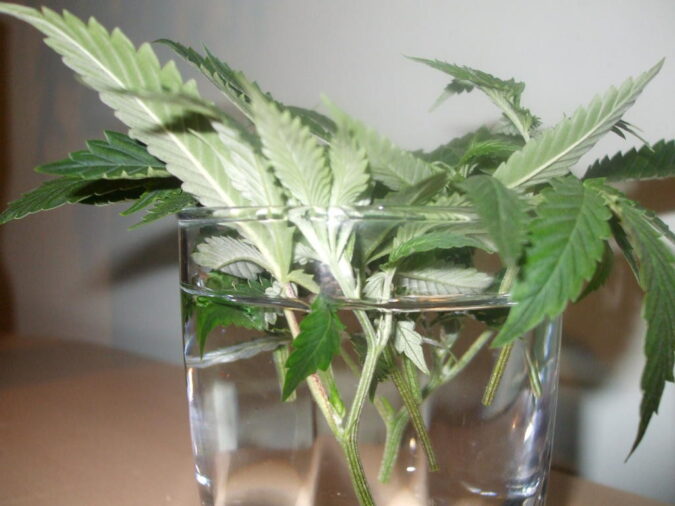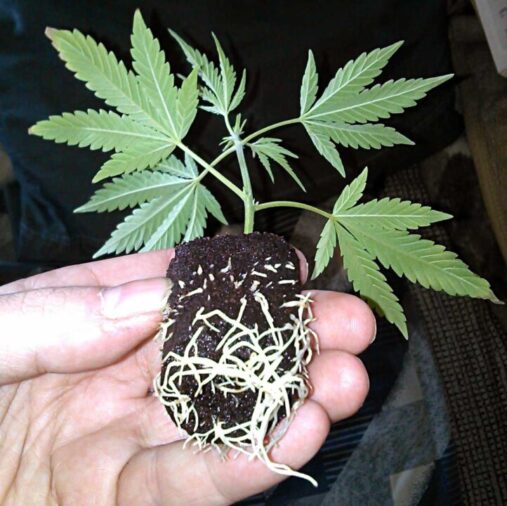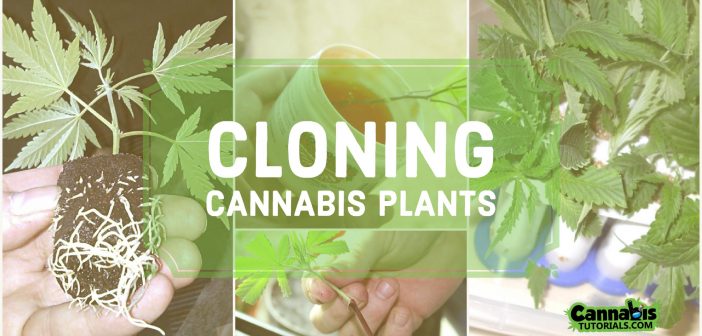Learning how to clone cannabis is easy and has many benefits. You’ll be able to closely control your plant’s genetics and all of your clones stay the same sex so you never have to worry about getting a male spreading pollen, and turning your crop into a seedy mess. Your clones will also take nutrients sooner leading to faster and more growth.
There are many variations of the cloning process and selecting the right technique will depend on your experience and growing conditions.
Major Cannabis Cloning Methods
- Plugs such as Rockwool, peat plugs, or rapid rooters
- Passive wicking
- Active systems, aeroponic style cloning systems
Cannabis Cloning Supplies
- Sterile scalpels
- Cloning Gel (I recommend Clonex cloning gel.)
- PH’d water 6.5-6.8 for soil, 5.8-6.0 for hydro
- Various containers and a shot glass for your cannabis cuttings and cloning gel
- Humidity dome
Choosing a Mother Plant
In order to clone cannabis, you will need to have a mother plant that has become bushy, and has some extra growth shoots that we can trim for our clones. When selecting your mother plant, keep a few things in mind.
Your cannabis clones will be exact copies of the donor (mother) plant. Because of this, you want to choose a plant that has the phenotype you want to keep. Given 5 seeds with the same genetics, they can present in five different styles, much like siblings can look different even with the same genetic stock (parents). For the purposes of cloning, unless you are creating plants for a breeding program you will want to clone female plants. This is so that buds are produced rather than pollen. This is why they are referred to as ‘mother plants’.
Some questions to consider when selecting what cannabis plant to clone are:
- Is it the right height and width for your grown space and style?
- Has it grown nice and strong?
- Does your strain eat up nutrients?
- Has your plant ever had issues with pests?
- Have you enjoyed using this strain and want to keep in your grow?

Selecting a cannabis cutting:
Branches with several nodes that are fully mature are best to select. I look for the thickness to be a little smaller than a pencil, and generally not too woody of a stem. I like to clone just before pruning so that I can take lower branches that will not get enough light if left on the mother plant. Use your scalpel to make a 45 degree cut across the stem. Avoid using scissors and they can crush your plant and close off capillaries, causing stem rot. You want a nice clean cut, with some surface area for the cloning gel to stick to.
Aim for just below a growth node, at least 4 nodes down from the tip. I find cuttings around 6 inches long work well. Immediately place your cuttings into PH’d water to avoid air getting into the stem, and creating an embolism in your cannabis clone which could kill it. Putting your cuttings into PH’d water gives you time to collect enough cuttings for your needs without having to take a cutting, clone it and repeat.
Creating Cannabis Clones
 If you are just starting to learn how to clone cannabis, and just want to see it work it is easy. The most basic form of cloning cannabis plants is to just leave cuttings in a glass of water, often by a windowsill or other light source. Supposedly you can get roots inside of seven days, but I have never been successful with this method at all. In my opinion, pretty much every other method is superior for cloning cannabis.
If you are just starting to learn how to clone cannabis, and just want to see it work it is easy. The most basic form of cloning cannabis plants is to just leave cuttings in a glass of water, often by a windowsill or other light source. Supposedly you can get roots inside of seven days, but I have never been successful with this method at all. In my opinion, pretty much every other method is superior for cloning cannabis.
Cloning Cannabis with Plugs:
 If you are using plugs for cloning cannabis, soak them with PH’d water and then let them drain so they are nice and wet but not soaked. If you have a bunch of cloning gel, I like pouring a bit into the hole in your plug where you will be inserting the stem. Pour some cloning gel into a shot glass so that you don’t risk contamination of the jar. Take your cutting, dunk it into your cloning gel and get at least an inch of stem covered as well as you can( more is better), and carefully insert into the plug.
If you are using plugs for cloning cannabis, soak them with PH’d water and then let them drain so they are nice and wet but not soaked. If you have a bunch of cloning gel, I like pouring a bit into the hole in your plug where you will be inserting the stem. Pour some cloning gel into a shot glass so that you don’t risk contamination of the jar. Take your cutting, dunk it into your cloning gel and get at least an inch of stem covered as well as you can( more is better), and carefully insert into the plug.
My preferred plugs for cloning cannabis are Rapid Rooters. I like these plugs because they biodegrade in my soil, and provide a nice porous environment for my roots to start their growth off right. If your clone doesn’t feel like it seated firmly in the plug you may want to backfill with a pinch of soil, or vermiculite if using these as they don’t like to compact around the stem. If I use Rockwool or peat plugs, I like to take my finger and compact the plug around the stem gently so that your cannabis clones stand up on their own little better.
Growing Strong Clones:
 Take your cannabis clones, place those into a tray with a humidity dome then spray the leaves and lid with some water, distilled water is preferred here as tap water can have chlorine or chloramine in it, which can be tough on your plants as they will be in a fragile state for a few days.
Take your cannabis clones, place those into a tray with a humidity dome then spray the leaves and lid with some water, distilled water is preferred here as tap water can have chlorine or chloramine in it, which can be tough on your plants as they will be in a fragile state for a few days.
Many people find that cutting the tips off of the leaves for less plant mass helps clone success. The key here is to keep a humid, environment so that the plant does not transpirate, or evaporate off water and can focus on making nice strong roots. If you are keeping your clone tray in an environment that is a bit chilly, consider using a warming mat under your clone tray.
Passive Wicking
Another option for cloning your cannabis is passive wicking. Passive wicking cloning is my favorite way to clone cannabis. It is simple and effective and delivers great results. The basic method is to use solo cups with holes punched in the bottom, filled with pearlite and placed in water with a clone in them. This can work, but for just a couple of bucks, you can make the ultimate passive wick cannabis cloning setup!
For cloning cannabis in this style you will need a couple extra items:
- Horticultural vermiculite
- Ice tube tray
- Small container to hold PH’d water and Ice tube tray
- Drill and small bits to put some holes in your ice tube tray
Optional items
- Small air pump
- Tubing and fittings to connect air line from pump to air stone
- Air stone to help oxygenate your water, and help prevent any algae from forming
How to clone cannabis with passive wicking starts with the same process for taking clones. Instead of using pucks to hold the clones, we will use a slightly modified ice tube tray and vermiculite sitting in a small reservoir of water. Because the vermiculite is spongy and porous it will wick up the right amount of water for our new clones. Don’t worry about forgetting to water, and killing off all of your clones.
Preparing the passive cloning tray:
To set this cannabis cloner up, take your ice tube tray, and flip it over to the closed off end of the tubes. Drill several small holes, so that water can wick into your vermiculite. When looking for a tray I like the style with a rubber sheet that plugs off the ends so that it is easier to push out the root ball that forms. Many of these will work, the concept stays the same. You can use small disposable cups if you are in a pinch, but you will need more vermiculite.
Cloning with the passive wicking tray:
After your cannabis cloning tray is prepared, fill each tube with vermiculite, and pack lightly. Using a small container that will fit your cloning tray, fill it up halfway with PH’d water. Place your cloning tray into the water, and let soak for a few minutes until saturated. Take your cuttings, dip into cloning gel as normal. Take a small pokey and make a hole, and place your cutting inside, and pack the vermiculite around the stem to hold it upright. Once all of your cannabis clones have been planted, leave the tray in the reservoir, add in your air stone hooked to a pump to keep the water oxygenated and place the humidity dome over it.
Leave in 6500k daylight florescent lights and mist enough to keep the environment humid. leave your clones like this around a week, opening the vent holes in your humidity dome little by little and allowing more air as time goes on and you should have a great little root mass to start your plants off strong.
Push your clones out of the tubes, and carefully tease out the roots of the clone if it appears root bound. Plant as you normally would. If you are using hydroponic growing styles, you can still use this cloning method, but I like to dunk the root ball to gently rinse off the roots of my cannabis clone.
If you are cloning your cannabis for a hydroponic grow, I would recommend a more active cloning solution, as you probably have the parts around, if you are into making your own system, otherwise, there are a ton of great systems available for purchase.
Active Cloning:
If you are cloning cannabis for a hydroponic grow, I would recommend a more active cloning solution. Aeroponic cloners are my favorite cannabis cloning solution for active systems. You can get results with a top feed recirculating system, but you risk stem rot if your clones stay too wet all of the time.
Additives for Active Cloning:
Using these cannabis cloners is simple, fill with PH’d water, around 5.7-5.8 I like to add a rooting stimulator – check the label but 1 teaspoon per gallon is a general guide. When In doubt, start weak and ease into a stronger solution. Also, consider adding a silica product – this will assist in building strong cell walls and protect against bacteria. Continue by cloning as normal then place your clones in the slit of the neoprene collar so the stem is held in the air above your reservoir. After you turn your pump on it will begin to spray up at the roots of your plants. Just place the lid on, and put under your cannabis cloner under a gentle growing light.
Perks of Aeroponic Cloning:
Once nice feature is being able to check on the root growth, but don’t do this too often as roots do not like light being on them. It should still take a week or so for roots to fully develop. A nice benefit is that you can leave your new clones in these aeroponic systems as long as they are supported by the neoprene collar and the roots are not getting tangled up. Once done you are ready to place your cannabis clones into net pots and backfill with expanded clay that has been washed off to remove clay dust. Place into either an aeroponic or DWC style hydroponic system and watch your cannabis clones take off!.
Now that you know how to clone cannabis like a pro, let us know how your clones turned out in 2022!







3 Comments
Cool
Cloning has quite a few advantages over growing cannabis from seeds including: Guaranteed female plants: Female plants produce cannabinoid- and terpene-rich cannabis flower. When you cut clones from a mother plant that you know is female, you can guarantee that every clone you cut will also be female.
Cloning cannabis is relatively easy and requires just a few key items: Scissors (for taking cuttings off the mother plant) Razor (for trimming up cuttings) Rooting setup (tray/tray-cell insert/dome/root cubes/heat mat, or an auto-cloner)